Heating systems have come a long way since the hot air concept was born in the early 1900s. Today’s modern units are incredibly versatile and offer great value for money. Furthermore, people use warm air heating systems for residential purposes and often consider them environmentally friendly. So what are the key highlights of a warm air heating system? Stay with us as we delve deeper into this subject.
Warm Air Heating: What Is It?
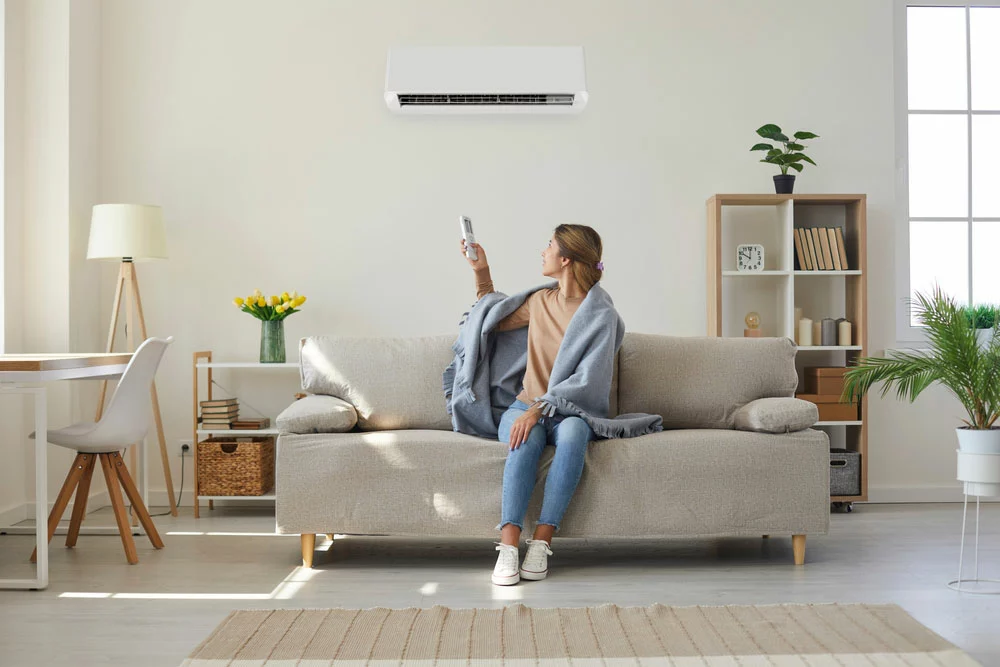
A young woman controls the AC.
Also known as dry systems, warm air heating systems absorb the air from external surroundings via vents. The air then moves through an air filter to a heat exchanger for further heating. Ultimately, the ducts or grills distribute the warm air throughout the house.
Traditional warm air heating was common in the United Kingdom and American homes, but the introduction of wet systems made them obsolete. Moreover, people who still use dry systems have advanced to modern ones such as air source heat pumps.
Apart from heating the house, you can use a warm air heating system to cool your home during hot seasons. As a result, these systems are suitable for countries with extreme seasonal temperature variations, such as North America.
How Does a Warm Air Heating System Work?
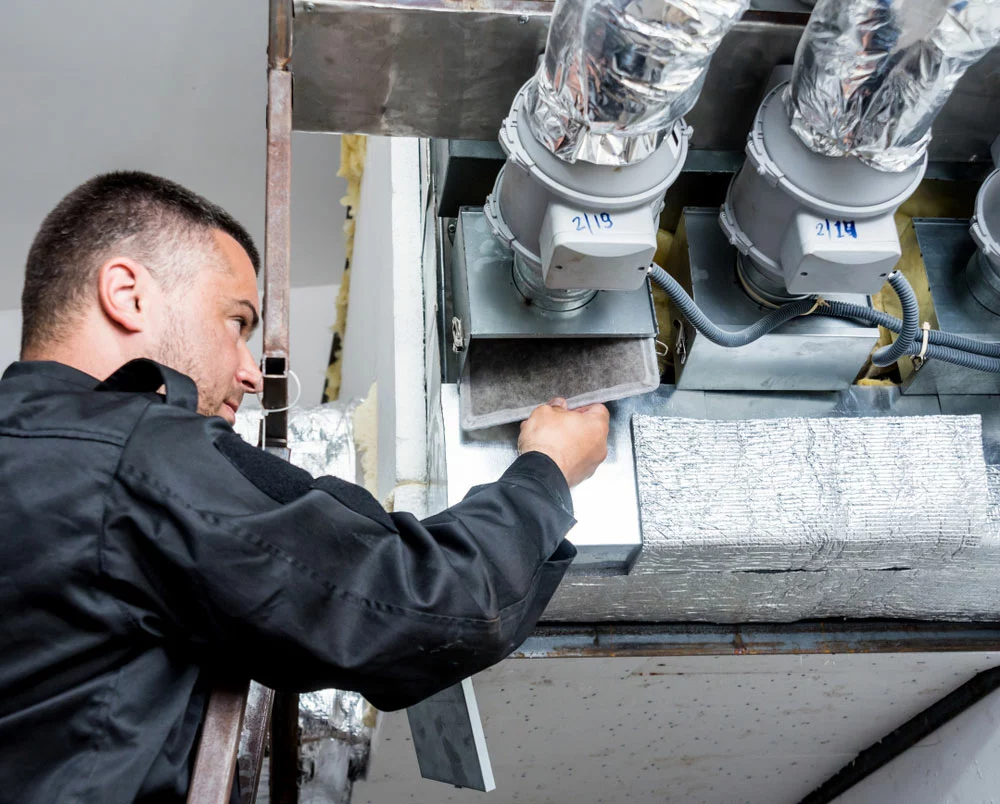
Ventilation cleaning.
A warm air heating system usually pulls or absorbs cool outdoor air through a vent or supply duct. Next, the cool air blows through a furnace heat exchanger or over a gas flame, depending on the consumer’s heating system type. Vents, grills, or air ducts spread warm air throughout the house.
After delivering the warm air, the heating system absorbs the cold air from home via return ducts. The cold air passes through the air handler, and the furnace of the heat source heats the air. After that, ducts spread warm air to the home, and the process continues.
The heating process repeats itself and stops when the home temperature becomes equivalent to that of the thermostat. Nonetheless, your heating unit depends on your preferred type of dry system.
4 Main Types of Warm Air Heating Systems
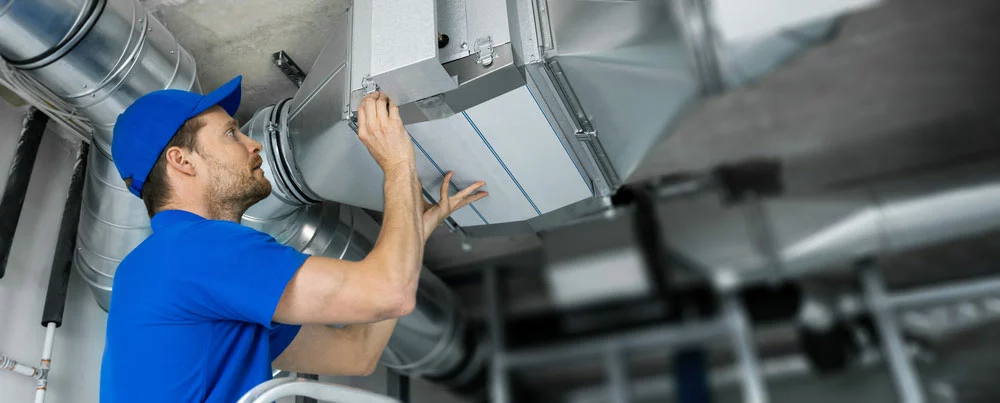
Repairing an HVAC system
Let us look at the four primary types of heating systems that apply the hot air heating concept.
Gas-Fired
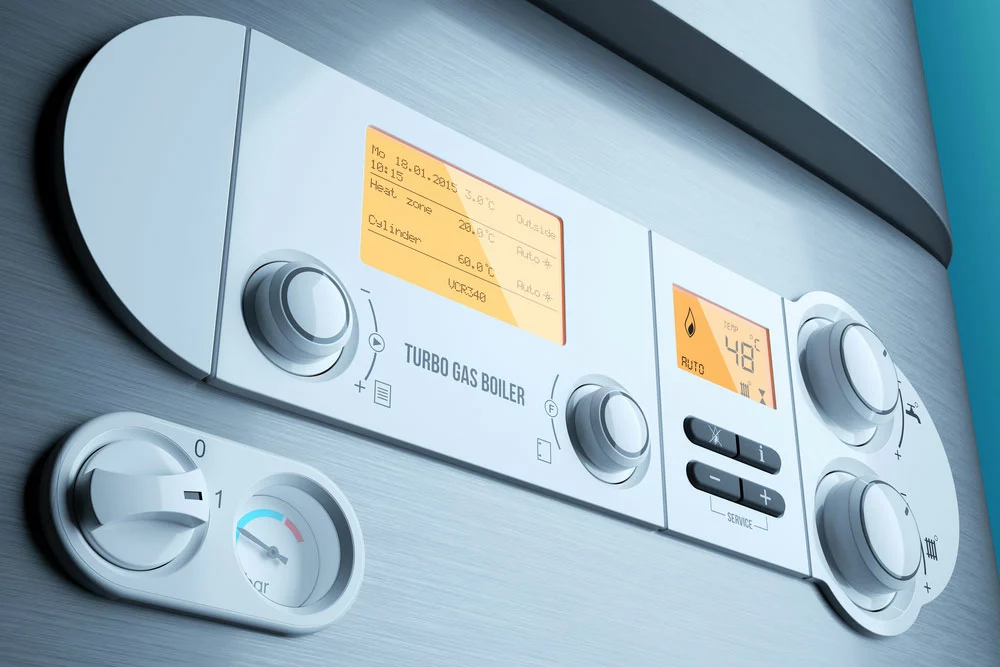
Gas-fired boiler control panel.
A gas-fired heating system takes in outdoor air and passes it over a gas flame (or gas-fired furnaces) for further heating. This natural gas furnace system heats your home more quickly since you directly place your ducts in areas that need heating.
Nevertheless, the advanced models of gas-fired systems can heat hot water, but the outdated ones cannot.
Air-to-Air Heat Pump
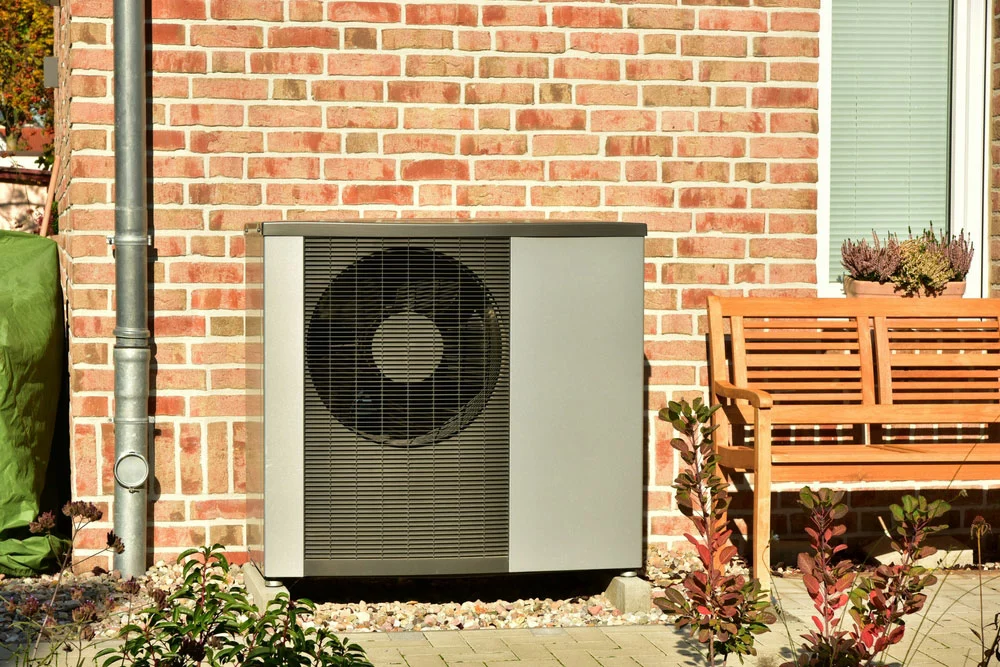
An Air-Air Heat Pump
This heating system meets the needs of either warming or cooling your home through electricity. The heating appliance uses electricity rather than fossil fuels, so it is low-carbon. Besides, you can gradually blend it with other systems (e.g., boilers) to yield heat.
Additionally, its functionality resembles that of air conditioners, but in reverse. Moreover, its installation is affordable and will help you save on energy costs.
Ground Source Heat Pump
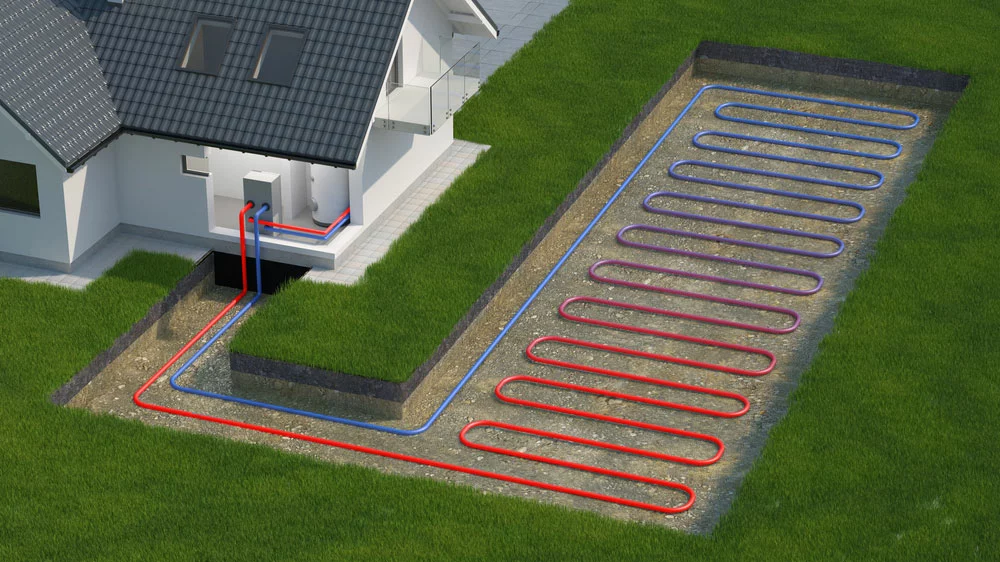
Heat Pump, ground source system
These pumps draw warm air beneath the ground through pipes and then pump it to the consumer’s home. The pumps contain geothermal HVAC fittings, enabling them to absorb heat from the sun’s or ground’s geothermal energy.
The UK’s average earth temperatures (8-11°C throughout the year) show that you can extract heat any day.
Hybrid Heat Pump
Setting up a hybrid heat pump requires you to fit this pump in conjunction with a boiler. The system can use the boiler’s LPG or electricity interchangeably, which reduces carbon emissions and saves on fuel.
Thus, you might need a hybrid heat pump to heat your home and save on fuel. Also, most high-efficiency furnaces utilize a hybrid system of heating.
Upsides and Downsides of Hot Air Heating System
Like any other equipment, a warm air heating system has pros and cons.
Upsides of Warm Air Heating
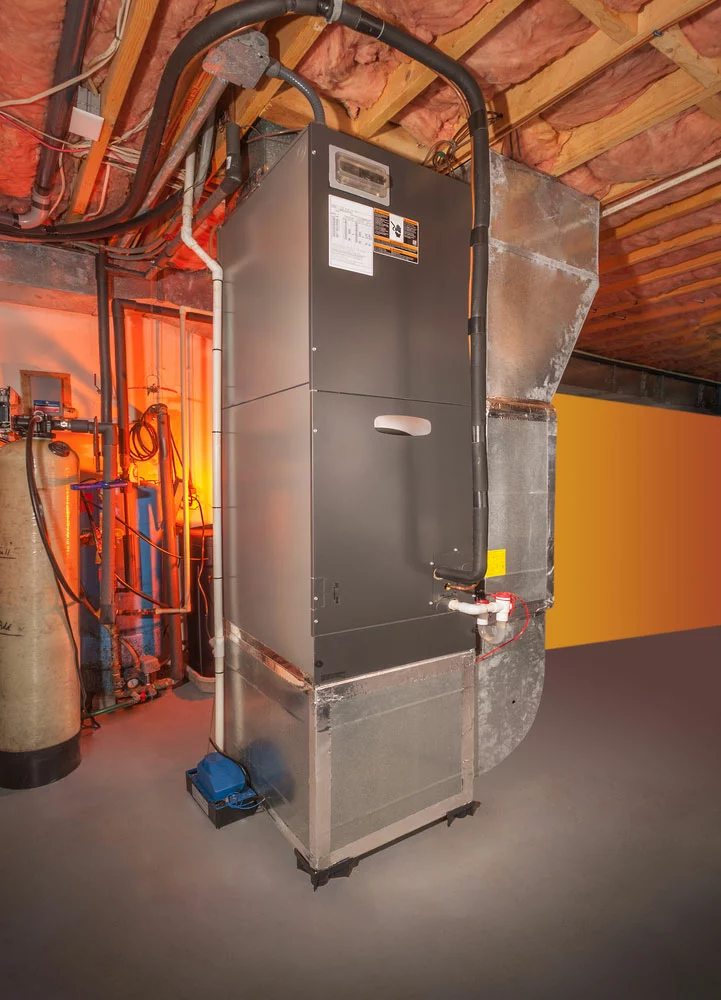
House-forced hot air and air conditioning system.
- It has a relatively fast warm-up time. Therefore, supplying your home with the necessary heat doesn’t take long.
- You also don’t need to incorporate radiators into your home as long as you have a forced-air heating system. Then free up space that the radiators would have otherwise occupied.
- Most warm air heating systems dissipate very little to no noise. Hence, your home remains calm all the time.
- In addition, the energy efficiency of warm air heating systems is top-notch. You’re sure to save up to 18% of the costs you’d have incurred with the other types of heating systems.
- Besides, you can monitor and control your energy use with a modern, warm air system thanks to the electronic controls synonymous with most of them.
- Lastly, some warm air heating (contemporary ones) feature electronic filtration. Keeping approximately 95% of harmful airborne particles at bay is important.
Cons of Warm Air Heating

Dust on the air duct system.
- The warm air heating system doesn’t facilitate heating water. So you may have to additionally spend on a gas boiler for compensation.
- Also, your ducts and vents will spoil at some point and thus require fixing. Retrofitting them is arduous and will leave some of the pipes visible.
- You may not have a variety of options to choose from with warm air heating compared to gas boilers. Primarily, this is because there are limited forced air heating systems and dealers. Hence, due to the lack of competitiveness, you may spend more than installing other systems.
- Further, there is just a single thermostat for forced air heating, which manages how hot or cold it is in each room, which can vary occasionally. Often, this one thermostat is not fully efficient.
- Lastly, you have to contend with the dust particles that the forced air heating system will undoubtedly blow into your house. It will happen irrespective of whether you have air filters or not.
Comparison between Warm Air Heating and Radiators
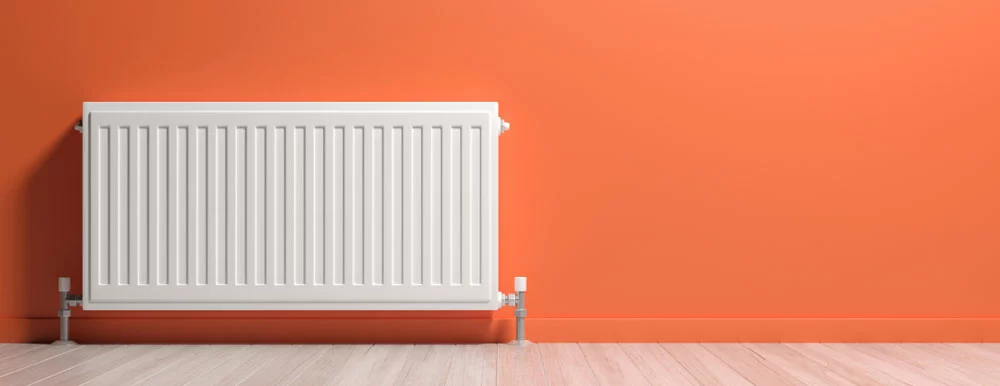
A radiator in the living room.
Warm air heating (dry systems) has given way to more advanced heating methods like central radiator heating (wet system). The significant distinction between dry and wet systems is the methods of generating and dispersing heat.
A dry system uses ducts, grills, or vents to distribute hot air throughout your house. A heat pump or a gas-fired unit is the warm air source in this system.
In contrast, a hot water system warms up water before supplying it to your home’s radiators. Usually, we use gas boilers to heat the water. Then, the water through pipes carries the heat to warm up the house throughout the winter and cold climates.
How to Shift from Warm Air Heating to Radiators
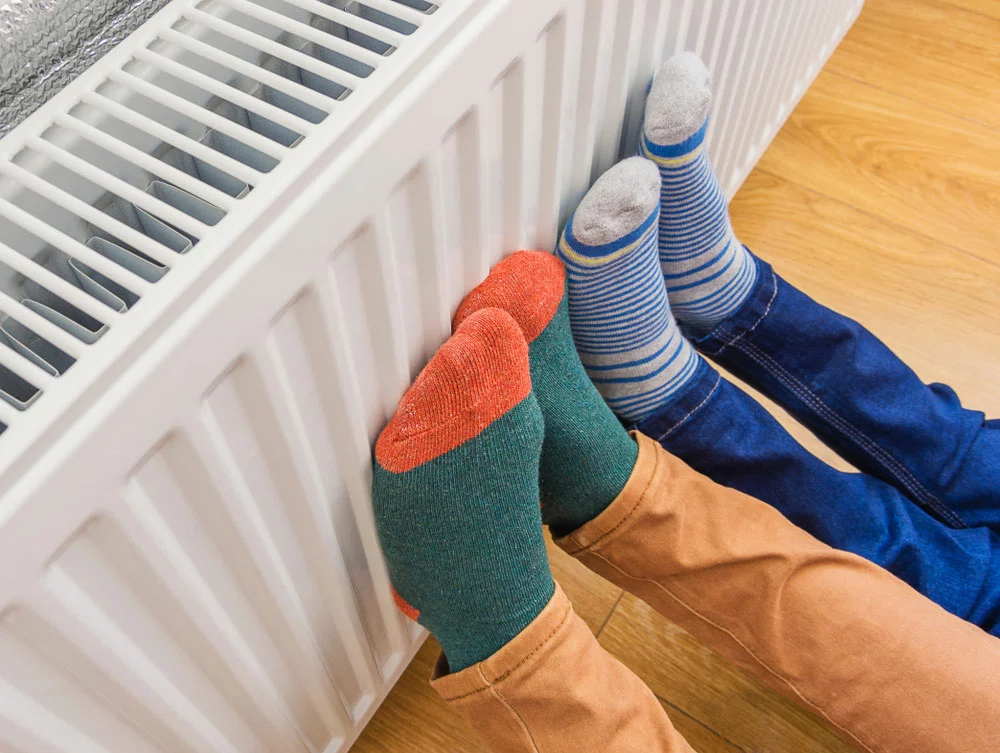
Warming cold feet on a heating radiator in wintertime.
Today, boiler technology has advanced more than the dry system, which has since become obsolete.
Therefore, a wet system with a radiator suits you if you want to replace the heating system in your present home. It is typically easier to install and offers a better option to meet your demands.
You may need to rearrange your furniture to create room for the newly installed radiators. Also, comparing the cost of upgrading a warm air heating system is a metric you should consider to come up with the best heating system.
This cost depends on the type of heating system and fuel you would use and the size of your home to accommodate your desired number of radiators.
FAQs
Is Warm Air Heating Cheaper Than Radiators?
Warm air heating systems are cheaper as compared to radiators. However, some hot air systems may achieve energy efficiency of higher percentages which can have a substantial influence on the price.
Is Warm Air Heating Economical?
Warm air heating is economical compared to other hearing systems. With this mode, you can save up to 18% of the costs you’d have incurred with other systems. However, when purchasing this heating system, the price tags will vary depending on the elements unique to that particular system. These features include durability, quality of the pipes and ducts, and efficiency.
What Is the Difference Between Forced Air and Central Air?
The main distinction is that “forced air” refers to the air distribution system, while “central air” refers to the actual central air conditioning system.
A forced air system usually transports air through ducts and vents while central air majors on the cooling system. Otherwise, you can use these two words reciprocally.
Is Hot Water Heat Better Than Forced Air?
Depending on your house setup or the available space, you can use either, but the dry heat option is quite cheap.
Also, for supplemental heating, you can consider both to reap from each method’s share of heating efficiencies.
Summary
With present-day technological advancements, heating systems have taken a positive turn. This blog enables you to choose the best heating system. Your budget, home size, and energy efficiency are some of the aspects that you should consider to meet your desired taste. Also, the heat output is excellent if you install the hot air heating system efficiently (with minimal heat loss mitigation measures).
